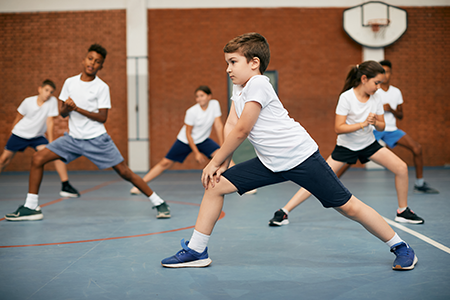HAMPTON CITY SCHOOLS EVERY CHILD, EVERY DAY, WHATEVER IT TAKES!
HEALTH, PHYSICAL EDUCATION & FAMILY LIFE

Pat Thompson
Curriculum Leader
Health, Physical Education &
Family Life
(757) 727-2013
Visit the Virginia Department of Education for the Standards of Learning in Health Education, Physical Education, Family Life Education and Driver Education.
Wellness involves the attainment and maintenance of physical, intellectual, emotional, and social fitness.
 The Health and Wellness Education program is designed to help students acquire and apply the knowledge, skills, processes and confidence needed to adopt and maintain a healthy lifestyle and select healthy and safe behaviors. Virginia requires all students to receive health and physical education instruction at all instructional levels in grades K-10. The program consists of health education, physical education, family life education, and driver education (10th grade).
The Health and Wellness Education program is designed to help students acquire and apply the knowledge, skills, processes and confidence needed to adopt and maintain a healthy lifestyle and select healthy and safe behaviors. Virginia requires all students to receive health and physical education instruction at all instructional levels in grades K-10. The program consists of health education, physical education, family life education, and driver education (10th grade).
Hampton City Schools provides a comprehensive health and physical education program envisions the following:
A well-articulated K-10 comprehensive physical education and health program that prepares all students to actively and effectively achieve and promote lifelong wellness.
A continuous sequence of learning, firmly rooted in both public health and educational research and effective practice.
An instructional sequence that provides all students multiple opportunities to use the acquired knowledge and skills in meaningful, authentic, and realistic ways.
A school community that recognizes and fosters the intrinsic value of wellness.
Elementary School
Students in elementary grades receive instruction once per week for 45 minutes. Health concepts are blended into physical education instruction.
Middle School
Students in middle school receive instruction every other day for 90 minutes. Students alternate units of health and physical education.
High School
Students in high school receive instruction every other day for 90 minutes. Students in high school receive instruction by semester:
Fall Semester
Physical Education I - 9th graders
Health & Driver Education II - 10th graders
Spring Semester
Health I - 9th graders
Physical Education II - 10th graders
HW PHILOSOPHY: A quality Health and Physical Education Program supports the physical, intellectual, and social-emotional development of students. When students maintain adequate levels of physical fitness and make healthy choices, the conditions and opportunities for learning also increase.
HW VISION: The HCS Health & Wellness Education Department will empower students to develop healthy habits, instill fitness literacy and become lifelong participants of physical activity.
HW MISSION: The mission of the HCS Health & Wellness Education Department is to provide a framework of instruction to our students encompassing building respect and instilling self-esteem. With a focus on the overall well-being of the “whole child” through lifelong fitness activities, our mission is to help students make good decisions about their health and wellness.
HW GOAL: The goal of the HCS Education program is to provide students with the knowledge and skills to value and apply physical activity and its benefits for a lifetime. Through active participation in movement and sport, students will foster an appreciation for personal fitness and other social skills vital to becoming healthy, productive members of the community.
 Hampton City Schools physical education program follows the 2015 Physical Education Standards of Learning. The standards reflect a comprehensive approach to learning and describe the developmental nature of understanding human movement concepts and attainment of skills (Motor Skill Development). Student knowledge of anatomical structures and functions has been scaffolded to provide context for improving skills (Anatomical Basis of Movement). The inclusion of anatomy and physiology concepts extends health-education knowledge, helps students understand movement, and prepares students for biology and other courses related to health sciences. The topics of personal fitness planning and physically active lifestyles have been combined to reinforce and emphasize that a person cannot have personal fitness without a physically active lifestyle. The addition of the concept of energy balance is essential for understanding the need for caloric intake to support body functioning and caloric expenditure for optimal cognitive and physical performance and healthy weight. Understanding energy balance provides the foundational knowledge necessary to empower students to think critically about their nutrition and activity choices and changing needs throughout life.
Hampton City Schools physical education program follows the 2015 Physical Education Standards of Learning. The standards reflect a comprehensive approach to learning and describe the developmental nature of understanding human movement concepts and attainment of skills (Motor Skill Development). Student knowledge of anatomical structures and functions has been scaffolded to provide context for improving skills (Anatomical Basis of Movement). The inclusion of anatomy and physiology concepts extends health-education knowledge, helps students understand movement, and prepares students for biology and other courses related to health sciences. The topics of personal fitness planning and physically active lifestyles have been combined to reinforce and emphasize that a person cannot have personal fitness without a physically active lifestyle. The addition of the concept of energy balance is essential for understanding the need for caloric intake to support body functioning and caloric expenditure for optimal cognitive and physical performance and healthy weight. Understanding energy balance provides the foundational knowledge necessary to empower students to think critically about their nutrition and activity choices and changing needs throughout life.
Physical Education content includes:
Motor Skill Development
Anatomical Basis of Movement
Fitness planning
Social Development / Sportsmanship
Energy Balance
Lifetime sport activities
The Five for Life™ curriculum is our guiding document along with the Virginia Standards of Learning for Health and Physical Education. Five for Life™ is a research-based K-12 curriculum that incorporates fitness and nutritional concepts taught primarily through movement. Sample lessons from the elementary, middle and high school curriculum can be viewed by clicking the links below. The Virginia Standards of Learning can also be found at the links below.
Five for Life Sample Lessons
Physical Education Standards of Learning:
Elementary School |
Middle School |
High School |
Hampton City Schools health education follows the 2020 Health Education Standards of learning. In health education, students will learn essential health concepts, develop understanding of health information in order to make healthy decisions, and actively advocate for their own health, as well as the health of their peers, families, and communities.
Program Overview
Health education content includes instruction in:
Body Systems
Nutrition
Physical Health
Disease Prevention/Health Promotion
Substance Abuse Prevention
Safety/Injury Prevention
Mental Wellness/Social and Emotional Competence
Violence Prevention, Community/Environmental Health
CPR and AED training (grade 9)
Health Education Standards of Learning
Elementary School |
Middle School |
High School |
Program Overview
The FLE program for students is taught by health and physical education teachers. Students in elementary grades K-3 focus on family, safety, and in 4th and 5th, puberty. In grades 6-10, students are taught that abstinence from sexual activity is the only way to guarantee the prevention of pregnancy and sexually transmitted infections. The family life education unit includes instruction on anatomy, abuse, internet predation, and healthy dating relationships.
Grade 9 - 10 Family Life Education Parent Information Letter rev 2023.03_Vietnamese.pdf
Grade 9 - 10 Family Life Education Parent Information Letter rev 2023.03_Swahili.pdf
Grade 9 - 10 Family Life Education Parent Information Letter rev 2023.03_Tagalog.pdf
Grade 9 - 10 Family Life Education Parent Information Letter rev 2023.03_Pashto.pdf
Grade 9 - 10 Family Life Education Parent Information Letter rev 2023.03_Spanish.pdf
Grade 9 - 10 Family Life Education Parent Information Letter rev 2023.03_Chinese.pdf
Grade 9 - 10 Family Life Education Parent Information Letter rev 2023.03_Farsi.pdf
Grade 9 - 10 Family Life Education Parent Information Letter rev 2023.03_Gujarati.pdf
Grade 9 - 10 Family Life Education Parent Information Letter rev 2023.03_Arabic.pdf
Grade 6-8 Family Life Education Parent Information Letter rev 2023.03_Swahili.pdf
Grade 6-8 Family Life Education Parent Information Letter rev 2023.03_Tagalog.pdf
Grade 6-8 Family Life Education Parent Information Letter rev 2023.03_Vietnamese.pdf
Grade 6-8 Family Life Education Parent Information Letter rev 2023.03_Spanish.pdf
Grade 6-8 Family Life Education Parent Information Letter rev 2023.03_Pashto.pdf
Grade 6-8 Family Life Education Parent Information Letter rev 2023.03_Gujarati.pdf
Grade 6-8 Family Life Education Parent Information Letter rev 2023.03_Farsi.pdf
Grade 6-8 Family Life Education Parent Information Letter rev 2023.03_Arabic.pdf
Grade 6-8 Family Life Education Parent Information Letter rev 2023.03_Chinese.pdf
Grade 4-5 Family Life Education Parent Information Letter rev 2023.03_Spanish.pdf
Grade 4-5 Family Life Education Parent Information Letter rev 2023.03_Gujarati.pdf
Grade 4-5 Family Life Education Parent Information Letter rev 2023.03_Pashto.pdf
Grade 4-5 Family Life Education Parent Information Letter rev 2023.03_Chinese.pdf
Grade 4-5 Family Life Education Parent Information Letter rev 2023.03_Farsi.pdf
Grade 4-5 Family Life Education Parent Information Letter rev 2023.03_Arabic.pdf
Grade 4-5 Family Life Education Parent Information Letter rev 2023.03_Swahili.pdf
Grade 4-5 Family Life Education Parent Information Letter rev 2023.03_Tagalog.pdf
Grade 4-5 Family Life Education Parent Information Letter rev 2023.03_Vietnamese.pdf
Grade 0-3 Family Life Education Parent Information Letter rev 2023.03_Swahili.pdf
Grade 0-3 Family Life Education Parent Information Letter rev 2023.03_Spanish.pdf
Grade 0-3 Family Life Education Parent Information Letter rev 2023.03_Pashto.pdf
Grade 0-3 Family Life Education Parent Information Letter rev 2023.03_Gujarati.pdf
Grade 0-3 Family Life Education Parent Information Letter rev 2023.03_Farsi.pdf
Grade 0-3 Family Life Education Parent Information Letter rev 2023.03_Chinese.pdf
Grade 0-3 Family Life Education Parent Information Letter rev 2023.03_Arabic.pdf
Grade 0-3 Family Life Education Parent Information Letter rev 2023.03_Tagalog.pdf
Grade 0-3 Family Life Education Parent Information Letter rev 2023.03_Vietnamese.pdf
Program Summary by Grade Level
Elementary School |
Middle School |
High School |
Family Life Education - Parent Letters - Sensitive Topics
The Driver Education Standards of Learning for Virginia Public Schools provides the framework for the Curriculum Guide for Driver Education in Virginia, which defines the skills and competencies necessary to become a proficient user of the highway transportation system. As prescribed by §22.1-205 of the Code of Virginia, the curriculum guide serves as the Board of Education’s approved program of study for public, private, and commercial driver training school programs. Public and private school driver education programs are approved by the Board of Education, and commercial driver training schools are approved and licensed by the Virginia Department of Motor Vehicles.
The Driver Education Standards of Learning focus on core concepts and procedures and set clear, concise, and measurable expectations for novice drivers. The standards, which have been refined through public hearings and numerous rounds of feedback from parents, teachers, administrators, and representatives from higher education, are informed by teachers’ experience, content experts, research and national standards. Parents are encouraged to work with their children to help them achieve these standards. Virginia Standards of Learning for Driver Education
Getting your driving license is an exciting new adventure, especially for a teenager. With the new license comes new-found freedom. However, driving privileges also come with great responsibility. To become a safe licensed driver, our students are required to follow a path of education and practice to prepare for the tasks ahead. The driver education theory course is offered as part of the tenth grade health education curriculum in all high schools during the first semester. When the classroom theory phase has been passed, the student will receive the green DEC-1 card.
When the student reaches the age of 15 years and 6 months, they can go to the Division of Motor Vehicles (DMV) and take the learner's permit test. When the student has both the green card and learner's permit, they may apply for Behind-the-Wheel instruction here. The fee for Behind-the-Wheel is determined by the amount of state funding and varies from year-to-year..
If you need additional information on the Driver Education program, contact:
Classroom Instruction: Patricia Thompson - Curriculum Leader for Health & Wellness Education (pthompson@hampton.k12.va.us).
Behind the Wheel Instruction: Patricia Thompson - Curriculum Leader for Health & Wellness Education (pthompson@hampton.k12.va.us) For more information about Behind the Wheel, click here.